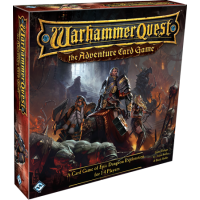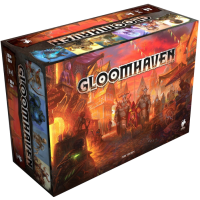Massive Darkness: Helscape Board Game Review
Related Products

Note: I've played quite a few dungeon crawlers, including Descent 2 , Imperial Assault , Jaws of the Lion , Warhammer Quest , Silver Tower , and Blackstone Fortress . I invested in the first Massive Darkness , but it didn't appear on the table very often - the game seemed too dark and full of fiddling - so I ended up selling it. I liked the intended gameplay and setting changes of the sequel, so I invested in Massive Darkness: Hellscape and recently received the box.
GAME PROCESS

So far I've played 3 missions not counting the intro scenario: the first with 2 characters, the second and third with 3. I've tried 4 of the 6 base classes (rogue, paladin, wizard and berserker).
The game consists of a chain of independent scenarios, slightly connected by the plot. No leveling is saved between scenarios (the Heavenfall app does add a campaign mode, but I haven't tried it yet). The map is built from two-sided tiles; the description of each scenario indicates which tiles to use, where the starting mobs, spawn points, doors, treasure chests and monster portals are located. If you played "Zombicide", the layout is quite similar and the gameplay is partially similar. There are 9 scenarios in the base (plus a very easy training mission) + a few more kickstarter goals.
Each game round consists of an action phase, an enemy phase, a leveling phase, and a darkness phase. During the action phase, heroes have 3 action points available, which can be spent on movement, attacks, exchanges, and special actions. Then comes the phase of enemy actions; they each have 3 action points. After that, if the heroes have gained enough experience, they can level up their characters, which increases the HP/mana reserves and gives a new skill (the level of the dungeon can also be leveled, making the enemies more dangerous). At the end of the round, the darkness counter moves, and if it stops at certain divisions, some events will occur.
COMBAT

The combat here is similar to the first "Massive Darkness" . Players collect a set of dice depending on the available equipment and the location (in the dark/in the light). The enemy then adds their defense dice to the set based on their defense score and the number of minions accompanying them (in the case of the mob leader), after which all dice are rolled. Symbols of swords - hits, symbols of shields on the defense cube - a block of losses. Roll results can be modified by skills, spells, and/or enemy abilities. Taking damage from the crowd first takes minions (which weakens their available dice pool) one by one until only the leader is left. He's basically the weakest of the mob because he won't get any bonus dice when fighting you head-to-head.
Melee attacks hit targets in the same zone as you, magic attacks hit targets in the same or adjacent zone, and ranged attacks hit no closer than an adjacent zone, but with an unlimited maximum radius (if you have line of sight).

Enemies use their weapons when attacking (it can be both melee and ranged). Their rolls are similar to player rolls, except they don't use the shadow cube and mana symbols. In general, the fighting game is now straightforward, although there are a few flaws. First, many skills and abilities are activated strictly in certain situations. There are basically three keywords that are used: attack, defense, and combat, followed by a number (almost always 1) that indicates how many times the ability can be used. Attack skills work only when the hero or enemies attack, defense, respectively, when they are attacked. The concept of "combat" is poorly defined in the rules; I understood that skills with this keyword can be used both offensively and defensively. You don't immediately get used to what skills you can use someday - especially considering that there are still a lot of nuances in the game.
Second, when attacking, the heroes roll all their dice (attack, defense, shadow if they are in a shadow area, and the enemies' dice), after which roll modifiers are applied. In which order is determined by the player. Finally, all sword symbols are counted, shield symbols are subtracted from them, and monsters receive the remaining damage (minions receive damage before leaders). In my opinion, the phase of calculating modifiers can become quite hemorrhoids when you have to take into account several factors at once.
For example, if I play a wizard in the shadow zone attacking a mob of fiends with 1 leader and 2 minions, he rolls his attack die (1 yellow) and a shadow die (purple), and the mob rolls a defense die (1 blue) and two minions (black). Let's say there are 2 swords, a shadow symbol on the purple die (allowing the wizard to activate an attack spell of his choice without spending mana), 1 shield on the defense die, and claw and scratch symbols on the black dice. The shadow symbol allows the wizard to cast a fire spell for free, which adds 2 more swords and a burning token. In the modifier calculation phase, the wizard will have to factor in the claw symbol, which in this situation detonates the fiend and deals damage to the wizard, then the scratch symbol, which deals additional damage to the wizard. The wizard then casts a shadow symbol to increase his attack. Now it's 4 swords against 1 shield, so 3 damage. The second devil is killed. And finally, the wizard places a burning token on the crowd. Now imagine having to do that in every fight. Very frozen.
CHARACTERS

The authors worked on making the character classes very different from each other. Each of the six classes has its own unique mechanics.
Berserker uses wounds to fuel his traits: the more damage he takes, the more he can do.
The wizard has a spell amulet that determines which spell is currently available, which is returned when the spell is canceled or when a unit of mana is spent. Gets a manageable cooldown.
The Rogue has a pouch of ability tokens; it draws 3 at the start of the turn and can be used in combos with actions.
The paladin has auras that can be cast on zones to buff or heal those in that zone.
The tracker has a push-your-luck mechanic: he draws as many shot cards as he wants, trying to get no more than 7 arrow symbols in total - if more, then instead of a shot of enormous power, he will get a stun.
And the shaman has peti and a table of elements that strengthen spells.
All the classes feel very different and I enjoyed getting to know each of them. For kickstarter purposes, there are also additional characters: a monk, a necromancer, a mechanic and a bard. I haven't tried them yet.
ENEMIES

Enemies are divided into three types: mobs, traveling monsters, and bosses. Mobs spawn at specific spawn points, either at the start of the game or as an effect from the darkness track. Each mob consists of one leader and minions equal to the number of players. Mobs will be filled with weapons as well as loot tokens. Weapons determine the type of attack available to them.
Roaming monsters are stronger than mobs. They appear either as a card effect or as a track of darkness. They don't have weapons, but they drop more than loot.
Bosses appear according to the scenario, usually in the final battle. How each boss acts is determined by his deck of cards. The two base bosses behave very differently.
Also, mobs and traveling monsters level up with players, becoming more dangerous.
LOOT

There is a lot of loot in this game. Maybe too much. Dozens of loot cards in three types (common, rare and epic) plus monster items. Fortunately, there is no limit to the number of items that can be carried; my heroes ran with a dozen items. Most of the loot can be used by any class, although of course there are also class-specific ones. You can also forge a random item of a higher level from junk items by spending 3 items of the same level and a forging action. The problem is that the result may not be optimal for your class, so whether it is worth the risk of spending an action and three items is another question.
I also cannot fail to note such an innovation as the bag of the month. At the start, there are 15 tokens in the bag: 10 regular loot and 5 rare. When you find a treasure in a room or take it from an enemy, you draw random tokens from the bag. Over the course of the scenario, new rare and epic loot tokens will be added to the bag - due to advancing the darkness track or other effects. So over time, the chances of finding good loot increase.
There are also sets of items; if you collect them, you will receive additional bonuses. However, in my games I've never come close to collecting a set because there's so much varied loot.
COMPONENTS

Typical CMON quality: great artwork, cool miniatures, and overall solid quality. Interestingly, the darkness track and boss cards are quite thin, but the class-specific components are as thick as the tokens. In general, there are a lot of tokens here: HP, mana, spawn points, forges, doors, pillars, portals, fire, ice plus special class ones. You will definitely need an organizer to make folding and folding easier. As for the cards... more cards. Monster cards for mobs, roaming monsters and their items of three levels (six in Heavensfall), door cards, loot cards of three levels, class skill cards. A card holder or plenty of free table space for multiple decks is desirable.

The rulebook is quite decently laid out. There is an alphabetical index, so finding the right points and keywords in general will not be difficult, but some of the rules that are often found are quite difficult to dig up. On the back is a note about the order of the move, and it is not detailed enough; hopefully an improved fan version will be released soon. The first few games we had to consult the rulebook a lot.
REPLAYABILITY
Replayability is enough. Many scenarios, different combinations of classes, random mob spawns... In general, you will explore the dungeons of "Massive Darkness" for a long time. And if you invested in the Kickstarter, there are even more mobs, roaming monsters and characters waiting for you in the Kickstarter goals.
CONCLUSIONS

A beautiful and fan-made dungeon crawler, the roots of which clearly grow from "Zombicide". Not as deep as Gloomhaven, but deeper than Warhammer Quest. The character classes are all unique and interesting, more varied than Descent or Warhammer Quest. The action is fun (at least when you pump a little), but sometimes it becomes frozen. There is not enough plot: this game is tied to individual scenarios, not a campaign. The components are mostly great, but the game lives up to its name; it is really massive and takes up a lot of space on the table, despite its light weight. I will definitely keep " Massive Darkness: Hellscape " in my collection.
USEFUL LINKS
Massive Darkness: Hellscape on BGG
https://boardgamegeek.com/boardgame/315610/massive-darkness-2-hellscape
VIDEO REVIEWS








